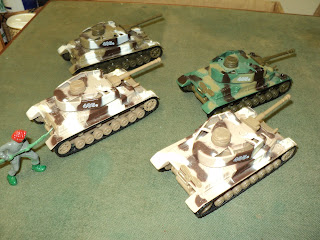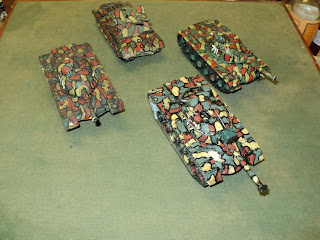 |
The Battlefield: attacks by two Corps (Columns) over the stream
whilst the third (North Column) makes a flank march |
The Union Army was ready for him ... but T'ai Kun Wu would make them wait a little longer. The Union commanding general had chosen a seemingly strong position from which to offer battle. There were indications, too of a considerable supply base established behind the rising ground before the Chinese Army. The question remained how to make the best use of his numbers, to drive the Union from this place and out of the rightful Imperial lands.
 |
| As seen from behind Union lines |
One slight advantage the losses to his army had reaped: the logistic situation was eased sufficiently that T'ai Kun Wu could spend a day, possibly two, in a careful reconnaissance of the position, from which intelligence gathered he might form a plan. Time was less a factor than it might otherwise have been.
The large hill - the Union called it 'Big Hill' - alongside and east of the road seemed too formidable an objective, and to fetch a march around it would be to cross its front and arrive at a stretch of the creek that ran though swamps and marshes. So difficult was this latter approach, that the Union had disdained to improve the position there by fortifications. It transpired, however, that instead of running in front of the hill, the creek ran through a pass between hill and escarpment, crossed there by a bridge recently repaired, whence it traced a path across its rear then southeastward. Even though this was rendered accurately (
Tony Adams's sketch map) by the officers charged with carrying out the reconnaissance, it passed T'ai Kun Wu's attention.
 |
Tony Adams's sketch map of Camp Supply, with
Union positions and Chinese battle plan
added. Very much Not To Scale. |
[
Aside: This was programmed: I considered a range of options, from a full frontal attack, to variations of combined front and/or flank attacks. The fact was, I simply overlooked the option of taking out Big Hill with one of the columns, then exploiting from there. That does not mean that would have been the plan adopted; it ought merely have been slotted in to the Chinese range of options. Having made the list, I rolled a D6 die, a '4' coming down upon two columns attacking the escarpment; the other carrying out a short flank march around the Union left into the shallow valley between the western edge of the escarpment and a round hill a considerable distance - over a mile - south of it. I then chose the columns' respective roles.]
 |
| 17th Brigade in action |
Having formed his plan, one further decision remained to set the wheels in motion. Seriously considering a night attack, the Chinese commanding general concluded that such was beyond the capacity of his army. Instead, on the late morning of August 2nd, he ordered his most powerful and freshest corps, North Column, on its flank march, and at precisely midday launched forward his other two corps, West and East columns, into a direct attack up the escarpment.
The Chinese Army comprised:
Commanding General: T'ai Kun WuNorth Column: Zeng Seng-Bao- 5th Regular Formation - 28 figures
- 17th Conscript - 19
- 18th Conscript - 19
- 19th Conscript - 19
- 1st Cavalry - 15
- 2nd Artillery - 2
Totals North Column: 102 (17,000) and 1 gun (8 cannon)
West Column: Li Xiucheng- 1st Regular - 21 figures
- 3rd Regular - 21
- 8th/9th Converged Light Infantry (Blue Leopards) - 20
- 11th Conscript - 18
- 12th Conscript - 18
- 1st Artillery - 2
Totals West (Reserve) Column: 100 (16,667) and 1 gun (8 muzzle loading rifles).
Note that 2nd Regular and 13th Conscript were, on account of losses, disbanded and the personnel distributed among other formations.
East Column: Li Kuan Yu- 6th Regular/13th Conscript converged formation - 21 figures
- 15th Conscript - 19
- 16th Conscript - 19
- 3rd Artillery - 2
Totals East Column: 61 (10,167) and 1 gun ( 8 cannon)
Totals Chinese Army: 263 figures (43,833) and 3 guns (24)
 |
West Column formations covered by
light infantry skirmishers |
Anticipating attack from north and west, the Union army had constructed a formidable defence line along the escarpment, and on top of 'Big Hill', with barbed wire entanglements here and there across the front. Though they didn't cover the whole front, those entanglements were to prove a considerable hindrance to the early Chinese assaults. To the escarpment front, General Jackson entrusted the newly arrive brigades, 17th, at the bridge end, and 19th, a battery of heavy artillery attached, and all under the command of Brigadier-General Early.
The defences of the refused flank were rather less complete, 39th Brigade ensconced in redan strongpoints covered by the machine guns to the flank not far from the cavalry horse lines, and the brigade artillery in the open field a short distance to their rear. Covering the flank of 39th Brigade was the cavalry, who mounted up as soon as action became imminent, and the flying artillery behind its works upon the Round Top Hill.
The Chinese ignored the 37th Brigade upon Big Hill as an objective too many, although had the South Column been available, no doubt T'ai Kun Wu would have found it useful to mask that position. For all its isolation, Isaac Bidwell's Brigade would once more have some impact upon events as they unfolded.
Finally, in reserve close by the Police Battalion lines and the ammunition storage dump, Major-General Jackson retained 38th brigade and the second battery, heavy artillery. With such arrangements the Major-General had prepared himself for whatever the Chinese army might throw at him.
Union Tenth Army looked like this:
General Officer Commanding: T. J. Jackson
- 37th Brigade: 16 riflemen, 1 gunner, 1 MG gunner = 18 figures
- 38th Brigade: 18 riflemen, 2 gunners, no MG = 20 figures
- 39th Brigade: 14 riflemen, 1 gunner, 2 MG gunner = 17 figures
- 17th Brigade (attached): 20 riflemen, 2 gunners, 2 MG gunners = 24 figures
- 19th Brigade (attached): 21 riflemen, 2 gunners, 2 MG gunners = 25 figures
- 10th Cavalry: 13 troopers, 1 gunner = 14 figures
- 110 Heavy Artillery: 4 gunners (2 guns) = 4 figures
- 210th Pioneer Battalion: 4 pioneers = 4 figures
Totals: 126 figures (21,000), 8 artillery (52), 4 MGs (28)
 |
The assaults go in. Where not held up by the wire,
East Column formations hit the Union lines
at the first rush |
He might have been less sanguine had he anticipated with what ferocity the Chinese would throw themselves into the assault. Covered by light infantry skirmishers, the West Column assaulted the western end of the escarpment, all along the 19th Brigade front, 3rd Regulars even striking the left flank of 17th Brigade. To their left, East Column splashed across the stream, the 6th Converged formation and 16th Conscripts surging up the slopes against rather ineffective rifle, machine gun and artillery fire. Although this fire failed to stop the Chinese formations, they brought their commander to a halt, Zong Ganshi, Li Kuan Yu, being laid low almost as the assault formations began their advance. Fifteenth Conscripts would have joined the assault upon the trenches, but were held up by the wire.
 |
The lead formations of North Column turn toward
the 39th Brigade redoubts |
Thus pinned, Early's two brigades were unable to prevent the development of North Column's enveloping moves. Prince Zeng Seng-Bao detached 18th Conscripts to attack the end of the escarpment line, where the field works had been bent back ninety degrees, and, after a short distance, a further right angle to form a species of bastion. Now 19th Brigade found themselves assailed from front and flank. As it happened, the brigade's volume of fire had quickly driven the Chinese skirmishers off, whereat the West Corps heavy formation columns took up the action. Before they could reach the Union works, 18th Conscripts were already in action on the flank, the fighting surging back and forth over the fortifications.
 |
Hand to hand fighting between 19th Brigade
battalions and 18th Conscript formation |
Had the front been struck at the same time, no doubt 19th Brigade would at once have been overrun, but as it was, the Union defenders, exacting a fearful toll upon the assailants, threw them back with losses so heavy, 18th Conscripts were driven altogether from the battle. All the same, it was a rather weakened 19th Brigade that were to meet the West Column formations as they closed.
 |
| 17th Brigade, shrouded in battle smoke. |
Yet West Column, like the East, was not able to develop its full strength along the 19th Brigade front. A clump of barbed wire held up 11th Conscripts whilst 1st Regular and 12th Conscripts forged ahead. Close by the fieldworks, the assault columns sent in one volley, before carrying on into the Union lines.
 |
11th Conscripts held up by wire as 1st Regular
and 12th Conscript surge on. |
Placed between 17th and 19th Brigades, the heavy artillery battery proved well covered from direct assault, as directly before them was another stretch of wire entanglements. So it was that 3rd Regular from West Column came up against the left wing of 17th Brigade. Like the rest of West Column, this formation couldn't quite reach the Union lines at the first rush. A volley felled a few Union soldiers but the return fire was far more formidable.
 |
3rd Regular avoid the wire to strike part of
17th Union Brigade. |
Without the early cover from skirmishers, two formations of East Column did contact the defenders at once; no volley, straight in to hand to hand close assault. Rifle and machine gun fire exacted a terrible toll on 6th and 16th both, but failed to stop them. The conscripts surged over the machine gun line, sparing neither gunners nor guns, and the two rifle battalions were also badly battered. Yet even such success came at far too high a price for the Chinese formations to endure. Back down the slopes they went, mere wreckage remaining of the 6,666 troops that went up them.
 |
| Union machine guns overrun - but at what cost? |
The Union had barely held against the three formations - almost 10,000 strong altogether - that had struck them at both ends of the line, but held them they had, and thrown them back with huge losses. But 17th brigade had lost its machine guns, and a good many of its own riflemen as well. Three formations repulsed, but there were five more - at least double the numbers - to renew the assault. The barbed wire would not for long hold up 11th and 15th Conscript formations, and the 1st, 12th Conscript and 3rd were just feet away from the lines, and closing.
 |
Western end of the battlefield. 18th Conscripts
repulsed, but their attack was mere overture. |
Far to the Chinese right, the North Column formations had become strung out as a certain amount of traffic congestion was holding up the cavalry and the formation's artillery. The repulse of 18th Conscripts created a further obstacle to the smooth unfolding of Prince Zeng's march. T'ai Kun Wu was beginning to concern himself lest the main assault might peter out before the flank attack could properly get under way.
 |
| The general view of the battlefield early afternoon |
He need not have been so worried...
To be continued: the second wave...



















































